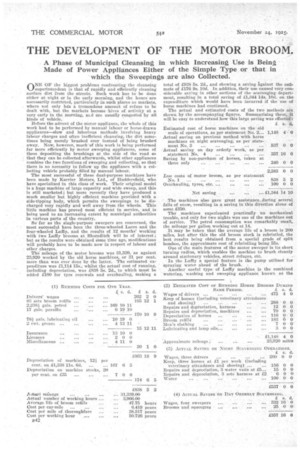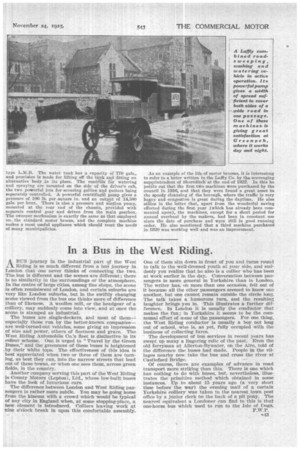THE DEVELOPMENT OF THE MOTOR BROOM.
Page 26

Page 27

If you've noticed an error in this article please click here to report it so we can fix it.
A Phase of Municipal Cleansing in which Increasing Use is Being Made of Power Appliances Either of the Simple Type or that in which the Sweepings are also Collected.
ONE OF the biggest problems confronting the cleansing superintendent is that of rapidly and efficiently cleaning surface dirt from the streets. Such work has to be done either at night or in the early morning, and the hours are necessarily restricted, particularly in such places as markets, where not only Ids a tremendous amount of refuse to be dealt with, but the markets become -hives of activity at a very early in the morning, aml are usually congested by an kinds of vehicle.
Before the advent of the motor appliance, the whale of this work had to be performed by manual labour or horse-drawn appliances—slow and laborious methods involving heavy labour charges and often inefficient cleansing, the dirt sometimes being merely brushed over instead of being brushed away. Now, however, much'of this work is being performed far more efficiently by motor sweeping appliances, some of these depositing the brushings at the side of the road so that they can be collected afterwards, whilst other appliances combine the two functions of sweeping and collecting, so that there is no necessity to fallow up the appliance with a collecting vehicle probably filled by manual labour.
The most successful of these dual-purpose machines have been made by Karrier Motors, Ltd., of Huddersfield, who have specialized in this class of work. Their original model is a huge machine of large capacity and wide sweep, and this is stilt marketed ; but more recently they have produced a much smaller but highly efficient machine provided with a side-tipping body, which permits the sweepings to be discharged very rapidly and well away from the wheels. This little machine has proved most efficient in service, and is being used to an increasing extent by municipal authorities in various parts of the country.
So far as the single-purpose sweepers are concerned, the most successful have been the three-wheeled 'mere and the four-wheeled Laffly, and the results of 12 months' working with two Laflly brooms at Shoreditch will be of interest; but as the results were obtained some time ago, modifications will probably have to be made now in respect of labour and other charges.
The mileage of the motor brooms was 31,339, as against 23,920 worked by the old horse machines, or 31 per cent. more than was ever done by the latter. The estimated expenditure was £1,114 15s., whilst the actual cost of running, including depreciation, was £838 5s. 2d., to which must be added £100 for tyre renewals and overhauling, making a total of 1938 Sc. 2d., and showing a saving against the estimate of £176 9s. 10d. In addition, their use caused very considerable saving in other sections of the scavenging department, resulting in a total saving of £1,344 14s. 10d. on the expenditure which would have been incurred if the use of horse machines had contirmed.
The actual and estimated costs of the two methods are Shown by the accompanying figures. Summarizing these, it will be easy to understand how this large saving was effected The machines also gave great assistance during several falls of snow, resulting in a saving in this direction alone of some £350.
The machines experienced practically no mechanical trouble, and only for two nights was one of the machines out of service. The petrol consumption was remarkably small, the mileage per gallon working out at 14.
It may be taken that the average life of a broom is 200 miles, but after this the old broom stock is rebristled, the best results being obtained from a special grade of split bamboo, the approximate cost of rebristling being 55s.
One of the main features of the motor sweeper is its short turning radius, which enables the machine to brush cleanly around stationary vehicles, street refuges, etc.
In the Lalfly a special feature is the pump utilized for spraying water ahead of the brush.
Another useful tYpe of Lailly machine is the combined watering, washing and sweeping appliance known as the
type L.18.1.B. The water tank has a capacity of 770 gals., and provision is made for lifting off the tank and fitting an alternative body in its place. The controls far watering and spraying are mounted on the side of the driver's cab, the two powerful jets for scouring gullies and gutters being separately controlled. A powerful centrifugal pump t.uivea pressure of 100 lb. per square in. and an output of 14,200 gals. per hour. There is also a pressure and suction pump, mounted at the rear end of the chassis, provided with separate control gear and driven from the main gearbox. The sweeper mechanism is exactly the same as that employed on the standard motor broom, and the complete machine makes a most useful appliance which should meet the needs of many municipalities.
As an example of the life of motor brooms, it is interesting to refer to a letter written to the Laffiy Co. by the scavenging superintendent of Shoreelitcli at the end of 1922. In this he points out that the first two machines were purchased by the council in 1916., end that they were found a great asset to the speedy cleansing of the borough, where the traffic is very heavy and congestion is great during the daytime_ He also
• state.s in the letter that, apart from the wonderful saving effected during the first year .(which has already been commented upon), the machines, except for a short period for annual overhaul by the makers, had been in constant use since the date of purchase and were still in good running order. He also mentioned that a third machine purchased in 1920 was working well and was an improvement.




































